Moreton Bay is a very enjoyable place to sail!
The only problem for us was that we had a four to five hour sail to get there, and then if a race was held up on the northern end, it added another three hours each way. This meant that we often had to leave home at dawn to be on the starting line on time for an afternoon race and sometimes wouldn’t be home and tied up till after midnight.
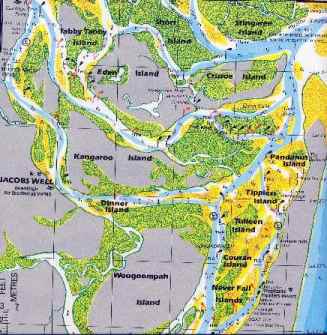
At night it is easy to get lost coming through the maze of islands
especially if some lights fail
Ken McKay mostly sailed with us as forward hand and navigator in these races. He had a great knowledge of the bay and his memory of the position of the eighty odd beacons in the maze of channels on the way home in the southern end (most unlit) was the only reason we made it home safely on some dark and rainy nights.
We were in the habit of keeping close to the edges of the channel and rounding close to the markers when bucking the tide. One evening just on sunset, we came very close to a pile that a pelican had settled on for the night and when we were only an arm’s length away he turned around, presented his back side, and sprayed us with his dinner of half digested fish.
It is strange how things go wrong when you are as far as you can get from home. We had sailed up to Brisbane to watch the start of the Brisbane to Gladstone Yacht Race on Good Friday, and had just started on our way back home against a freshening southerly, when the water impellor in our diesel motor disintegrated. This was a concern. We would be alright just sailing until we reached the south end of the bay proper, but then it would be dark and I didn’t like the idea of tackling the narrow channels the rest of the way home without a motor.
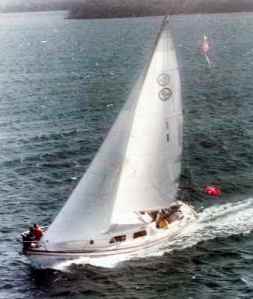 Geronimo
Geronimo from the air
We did have an SSB radio and were able to contact our neighbour who operated “Sea Air”, the local float plane service. He offered to hunt around for an impellor and fly it down to us. Despite it being Easter, he found one.
Without a motor and in a fresh south easterly it would have been a difficult sail home that night. Usually the new SE wind will last three days, but we were lucky that night when the wind turned back into a light northerly.
The float plane found us an hour before sunset, just as we were entering the first of the marked channels. We anchored, and the impellor was passed over to us. The impellor didn’t fit, but we were fortunate because as the sun set, the wind dropped out and a little north easterly set in at the same time as the tide turned in our favour and we were able to sail all the way home under the full Easter moon.
The Sea Air float plane was responsible for helping many in trouble. While on the water the plane had to obey the boating regulations, but as soon as it was in the air it was under the control of the Coolangatta control tower.
We had arranged to have a 28 ready for an owner in Sale (Vic) in time for the “Marley Point” race, and the arrangement was that if we delivered the boat in time, we could sail it in the race. It is always a risk expecting a boat that had never been afloat before to be ready to race.
We had arrived in Sale on the morning of the race and after meeting the new owner, launched and rigged the boat, put on supplies and motored down the Thompson River to Lake Wellington.
By the time we arrived it was dark and several hundred boats lined the shore getting ready for the start.
Our start time was 11PM and as we motored out to the start line, marked by strobe lights at either end, the navigation lights of the boats in the earlier starts formed strings of red dots in one direction, and green dots heading in the other.
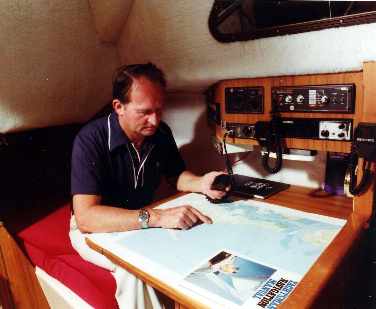
Rob at work.
It was time to get our sails up but our main halyard had disappeared up to the top of the mast and no one on board was fit enough to go up the mast to bring it down. The only thing was to lower the mast and retrieve the halyard. This was a job that I did not relish on a dark night with the boat rolling around. However, it came down without trouble but now we found that even with the mast down we could not reach the halyard end because none of us were able to climb out along the mast top.
Just as we were about to take the bolt out of the tabernacle to move the mast tip inboard a boat appeared out of the darkness to ask if we were in trouble. They had seen our mast head light come down and came over to investigate. They tried to pull the halyard out without success and suggested we raise the mast again and one of them would climb up and try and free it.
With the mast up again one of the boys was up the mast in seconds and came down with the halyard end. It seems that all the lines inside the mast had tangled during the road trip and there was too much friction with the mast horizontal to clear them.
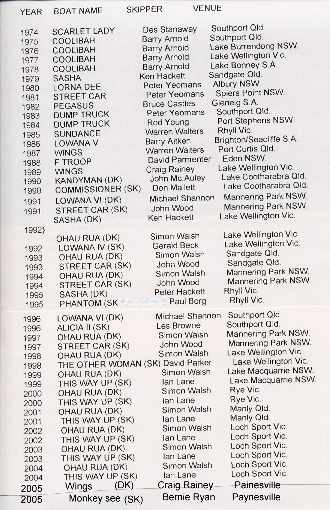
List supplied courtesy of Ross Corbin.
The lads in the “Hood 23” that had helped us, sailed off into the dark before we had a chance to thank them, and all I heard back when I called out after them was, “From Metung!”
So, whoever you were boys, THANKS. You saved us from an embarrassing situation.
As far as the race was concerned, by the time it was our start, the wind had dropped right away, and by the time we reached the narrows the tide had started to run in, and we were confronted by a string of stern lights drifting backwards out of the channel.
Only the boats in the first starts made it out to open water, and by the time the later boats got through, around sun up, the race was lost and the rest of the fleet just dots on the horizon.
At the time I am writing this, it is just sixty years since Pop Hooper pushed the bow of the little blue boat I had hired away from his jetty on Albert Park Lake. He called out after me, “If you get into trouble just throw the sheets away and sit in the middle of the boat.”
Maybe I can’t remember what I did the day before yesterday, but I can still remember every detail of that little boat, and that first day that I ever went SAILING.
Every year for the last thirty years the RL24 Association has conducted a championship series, and as I look through the list it is a little sad that the names of some of our most stalwart owners, who have competed every year, do not appear. Ross Corbin has been a tireless worker for the class since he purchased his boat thirty two years ago, and it is still in his family today.
Simon Walsh has won the championship no less than ten times over a period of twenty three years. Quite a remarkable record!
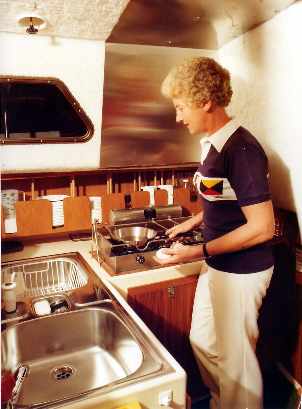
June
By 1988 I had been building boats for forty years, and June had been deeply involved for the last twenty. She had been first mate, forward hand, and cook during a thousand races, as well as running the office at work. We had brought up our two children and now it was time for a new chapter in our lives.
Until I started on this story I had never really reflected on events during this period. We had been so busy racing all over the countryside that I hadn’t even thought to go and thank the very people who had made it possible.
- To all the people who had worked with us over the years.
- To all the crews who had sailed with us.
- To all the yacht clubs who hosted those races, and the many race officials who gave their time, it really was appreciated even if we didn’t get around to telling you at the time.
THANK YOU.
I am flattered that during all those years so many people had the confidence in us to ask us to build them a boat.
Finally, thanks to Keith Merkley for his unending enthusiasm in hosting this site.
Rob Legg
October 2005